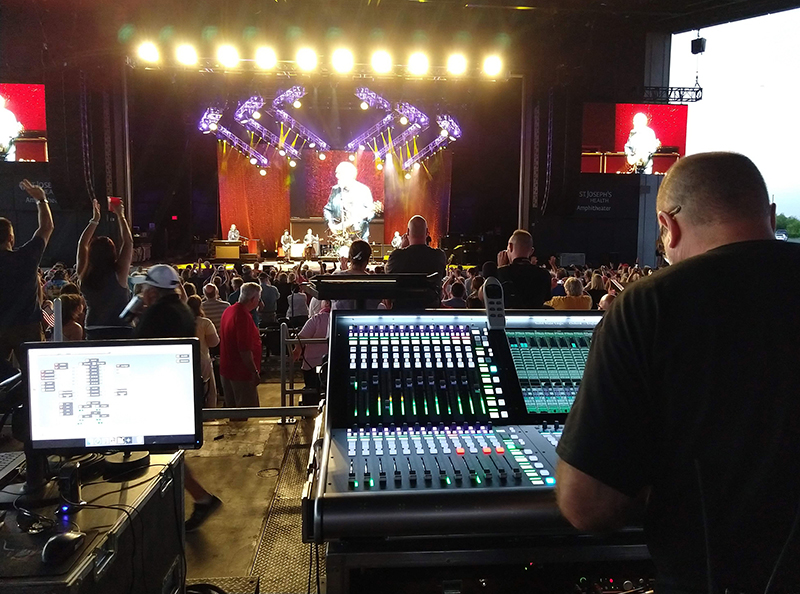
Ken “Pooch” Van Druten (FOH): I build banks of things that I prioritize by importance and how often I need access to them. Bank 1 on my console is often a mixture of input channels, groups, DCAs and matrix outputs. Anything that I need access to in a fast moment, I know that any time I go back to Bank 1, chances are that I have access to something I need quickly. This sometimes carries over into Bank 2 as well.
Past the first two banks, I start organizing inputs by instruments. Bank 3 is often drums across the entire console, Bank 4 is bass and guitar, and so on. I set these up in order that makes sense to me (and probably only to me). For the most part during a show I stay in Bank 1 and 2 unless I need to touch a specific input. Also, these two banks may contain copies of inputs from the other banks along with groups, etc. The center section is usually banks that are groups, DCAs and matrix outputs that are in order for quick access. There may be copies of individual groups, DCAs, matrix outputs in Bank 1 and 2 as well – I basically call them my “show” banks, providing access to things I require quick access to.
Further, any vocal channels (particularly a Lead Vocal) are copied in the same place in all banks, so if I’m buried in my input banks and working on something, I can still reach a vocal quickly for effect cues, etc. If the lead vocal lives on Fader 25 of Bank 1, it gets Fader 25 on all banks – I always have access to it, no matter what. I only do this with vocals.
Also, for possible emergency scenarios, I make layers that are copies of opposite fader banks. So, for instance, on Layer 2 of Bank 1, Faders 1 through 12 are a copy of Bank 1, Faders 25 through 36. (Confused yet?) So, I have a copy of an opposite fader bank if an entire fader bank goes on the fritz or one fader in that bank malfunctions. Remember, gear breaks and I always try to leave myself an out. Don’t get caught in the middle of a show without the ability to get at something.
Finally, I always land every input and fader, even channels I’m not using. I don’t ever want to be in a situation where there’s a channel that is open and not landed. If someone plugs something into that input, by accident or otherwise, and it is not landed, you’ll never be able to see what is happening with that open input. If this happens to you (raises hand), you’ll never do it again.
Ryan O John (FOH): As it turns out, I only have two hands… but that’s what snapshots and events are for – they’re my extra hands! Even in shows with 100 or more channels, for the most part, with some exceptions, only 50 to 60 of those inputs are being used at any given time. I still don’t have 50 to 60 fingers though, so those inputs need to be stemmed down to some controllable number of faders and knobs. My typical layout: inputs, groups, and VCAs all interspersed across the surface.
The idea is to get as many inputs into as few faders as manageable but still give you good control and quick access to the layers underneath. So, this could easily be achieved with VCAs, such as being able to put your entire drum kit into a single VCA, all bass inputs into a Bass VCA, all guitars or keys or vocals, etc., until all inputs are covered.
But VCAs have their limitations, the first being that they’re actually just a control group and don’t typically have metering; and the second being limitations of certain platforms – most analog and some digital desks only let you assign input faders to VCAs, which affects how you may want to use groups. Groups, on the other hand, have metering, and can also add serial processing to the channels assigned to it.
Ultimately I see the solution as a mix of both of these to achieve max control from minimal physical faders. My typical show uses a heap of groups – Kick Group, Snare Group, Drum Group, Bass Group, Guitar Group, Keys Group, Playback Group, Vocal Group, and Background Vocals Group, and of course more or less if other instrument types were added or removed. This already gets me down to nine faders controlling the overall show, but in my opinion that’s not enough control, so I also use VCAs. The major deciding factor between moving a VCA to change the level of something, and moving a group in that case would then be: do I want to drive it into or trim it back from the group processing, or just make it louder or quieter, wherein the VCA is typically controlling inputs feeding into the group, and the group is just the ultimate level of the instrument group.
A good example of this complexity is drums, I may have multiple kick mics, and maybe a trigger also, all feeding to a Kick Group, same for snare, and then of course there’s the rest of the drum inputs, all of which hit a Drum Group. I might also have a Drum VCA, but if the goal of this VCA is to control the drum level into the Drum Group’s processing, then it needs to include the Kick Group, the Snare Group, the additional drum inputs that feed the Drum Group. With this setup, I can throw a drum compressor on the Drum Group and use the VCA to drive into it harder, or to drive it less, and the group itself as the Master Drum Level, so you can really change the intensity of the drums from song to song or part to part by manipulating those two faders.
